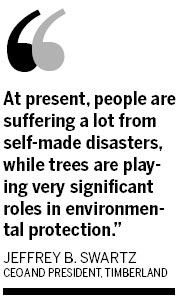Timberland takes up forestry management
|
Jeffrey B. Swartz, president and chief executive of Timberland Co, said his company was devoted to constructing a 'Green Great Wall' over the next 10 years by planting at least two million trees in Northern China in an effort to protect China and neighboring countries from sandstorms and to further help to relieve the impact of global warming. Adrian Moser / Bloomberg News |
Outdoor clothing company cultivates environmentally-friendly image
BEIJING - It may not surprise you that a company with a tree as its logo spends a lot of time in the forest. But it may surprise you just how involved it is and the level of commitment it has made.
As concerns over the environment grow due to the effects of global warming, US-based Timberland Co has announced that its tree-planting project in Horqin Desert in North China's Inner Mongolia autonomous region has borne fruit. The company has cultivated more than one million trees over the past 10 years in the environmentally fragile region.
Jeffrey B. Swartz, CEO and President of Timberland, the world's leading outdoor footwear and clothing company, told China Business Weekly: "At present, people are suffering a lot from self-made disasters while trees are playing very significant roles in environmental protection."
Horqin Desert is about 42,300 sq km, nearly equal in size to Switzerland. Over the past 30 years, the number of grazing livestock in the region has doubled due to the country's population boom. Warmer winters and less rainfall have left the fertile land susceptible to strong winds with devastating results.
Between March and April every year, wind storms originating from the desert blow millions of tons of sand as far as Hong Kong and Japan.
Swartz said that the tree-planting project was launched by Timberland in 2001, before the company entered the Chinese market. It said it represents its strong commitment and determination regarding environmental protection.
The project sees Timberland employees, business partners, students and even consumers being rallied to unite with millions of dollars of investment. They spent more than 37 million working hours in total. The one million tress are cover an area of about 1,000 hectares in the region.
In a partnership with GreenNet, a Japan-based nongovernmental organization, Timberland plans to restore the desert's grasslands by developing irrigation and planting new shrubs and trees while educating the local population on more sustainable farming practices.
Han Yu, a farmer aged in his 60s who lives in the Horqin Desert region, said that initially when Timberland employees came to plant trees the place was a stretch of wilderness with serious sandstorms and they were working under tough conditions.
As time went by, the yellow land turned green, Han said. "It is a satisfying project."

Swartz said: "Now Timberland is devoted to constructing a 'Green Great Wall' over the next 10 years by planting at least two million trees in Northern China in an effort to protect China and neighboring countries from sandstorms and to further help to relieve the impact of global warming."
As an outdoor footwear and clothes manufacturer, Timberland is committed to eliminating the use of chemicals linked to human or environmental harm.
For example, the company said that it had voluntarily chosen to phase out polyvinyl chloride (PVC), which is a material widely used in footwear and apparel manufacturing. It has been linked with environmental and health problems.
In 2007, Timberland introduced the Green Index, which is a measure of the environmental impact of its products. "Our goal is to provide consumers with visibility of the footprint our business creates," Swartz said.
Timberland has more than 1,000 outlets across China. The company has introduced various "green concepts" into its outlets. Currently, it uses recycled wood for making floors and panels for its outlets as well as all of the furniture.
All the varnish and paint used in its outlets meets the standards of the Leadership in Energy & Environmental Design, the company said.
"When we are setting up a new outlet, the priority is whether all materials we use can be recycled as much as possible," Swartz said.
The company also recently announced that it would be launching its eco friendly "Earthkeepers 2.0" boot this fall. The boots are designed to be broken down and recycled after use. Customers will be able to return the boots to any Timberland store for recycling when they don't want them anymore, rather than throwing them away.
Swartz said: "A new challenge for us is to design a kind of boots that can be disassembled and then used as fertilizer for tree-planting."
China Daily
(China Daily 06/07/2010 page16)









